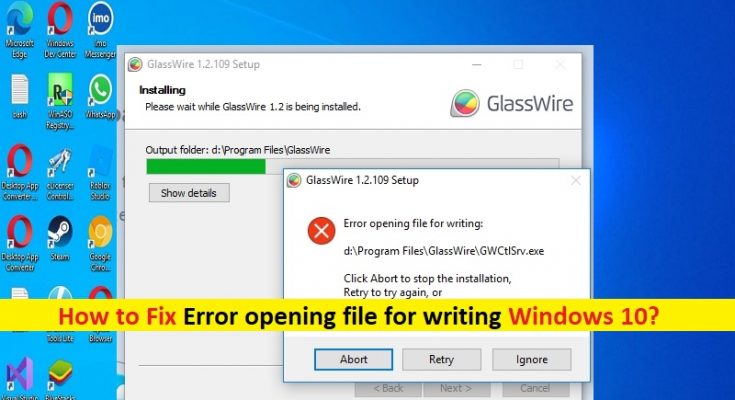What is ‘Error opening file for writing’ in Windows 10?
In this article, we are going to discuss on How to fix Error opening file for writing Windows 10. You will be guided with easy steps/methods to resolve the issue. Let’s starts the discussion.
‘Error opening file for writing’ issue in Windows 10’: It is common Windows Problem usually occurred when you install applications/programs like Steam, VLC, Wireshark, CCleaner, BSPlayer, etc. on a Windows operating system based computer. This issue basically affects any Windows applications and prevent it from installing. This issue indicates you are unable to install a application in Windows computer and when tried to install a new software, you experience ‘Error opening file for writing’ error.
There could be several reasons behind the issue including software compatibility issue, required administrator permission not given to installer, issue with security permission, interference of other conflicting software, and other issues. It is possible to resolve the issue with our easy instructions. Let’s go for the solution.
How to fix Error opening file for writing Windows 10?
Method 1: Fix Error opening file for writing issue with ‘PC Repair Tool’
‘PC Repair Tool’ is easy & quick way to find and fix BSOD errors, DLL errors, EXE errors, problems with programs/applications, malware or viruses infections in computer, system files or registry issues, and other system issues with just few clicks.
Method 2: Make sure no other installation is in progress
This issue can be occurred if another installation is already in progress. In such case, you will need to wait until finish the already running installation. To check this, you need to open ‘Task Manager’ app in Windows PC and check if any program is already in progress in computer. Once other process is finished installation, retry the installation for the app you were trying and check if it works.
Method 3: Disable UAC

Step 1: Type ‘UAC’ in Windows Search Box and click ‘Change User Account Control Settings’
Step 2: In the open window, slide down the bar to ‘Never Notify’ and click ‘Ok’ to save the changes on your computer
Step 3: Click ‘Yes’ to confirm and once done, retry installing a application and check if it works for you.
Method 4: Run the Compatibility Troubleshooter

Step 1: Find and right-click on installer executable on computer, and select ‘Properties’
Step 2: Click ‘Compatibility’ tab and click ‘Run Compatibility Troubleshooter’ button and follow on-screen instructions to finish troubleshooting, and hit ‘Apply > Ok’ button to save the changes and check if the issue is resolved.
Method 5: Change Permissions of Installation file

Step 1: Navigate to the location where the installation file is, right-click on the setup file and select ‘Properties’
Step 2: Click ‘Security’ tab, click ‘Edit’ to modify the security principle. Click ‘Add’, write ‘Everyone’ and click ‘Ok’
Step 3: Select ‘Everyone’ from the list and select every permission to assign Full Control, and then click ‘Apply > Ok’ button to save the changes. Once done, restart your computer and check if the issue is resolved.
Method 6: Remove traces of any previous or similar version of software
Step 1: Open ‘Control Panel’ in Windows PC and go to ‘Uninstall a Program > Programs & Features’
Step 2: Find and right-click on any previous version of software already installed in computer that you are trying to install, and select ‘Uninstall’ to uninstall it and after that, restart your computer and check if the issue is resolved.
Method 7: Run Disk Cleanup
Cleaning up the disk is necessary to clear any temporary files which prevent installation of newer version of software.
Step 1: Open ‘Disk Cleanup’ tool via Windows Search Box in Windows PC
Step 2: Select the drive to cleanup and click ‘Ok’ button to run the process. Once finished, restart your computer and check if it works for you.
Method 8: Change the download location of software
You can also try to fix the issue by changing the download location of software you are trying to install when prompted for the same, and check if it works for you.
Conclusion
I am sure this post helped you on How to fix Error opening file for writing Windows 10 with easy steps/methods. You can read & follow our instructions to do so. That’s all. For any suggestions or queries, please write on comment box below.



